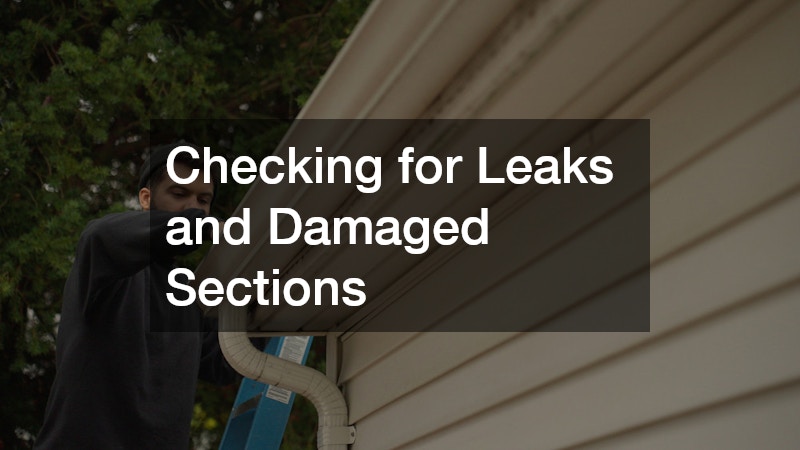As the crisp chill of autumn begins to settle in, homeowners across the country start preparing their properties for the colder months ahead. One of the most important yet often overlooked tasks during this seasonal transition is performing thorough gutter cleaning and a roof inspection. Neglecting these essential maintenance steps can lead to serious issues such as water damage, ice dams, and costly repairs once winter weather takes hold. Gutters and roofs work together to protect your home from the elements, directing rain and melting snow away from the foundation and preserving the integrity of the structure. Before temperatures drop and snow accumulates, taking the time to assess and maintain these components can make all the difference in ensuring a safe and secure home. If you are planning a roofing installation, this is also the ideal time to inspect your existing roof and gutters.
Roofers performing an inspection before winter not only improves the functionality of your drainage system but also extends the lifespan of your roofing materials. This process helps you identify small problems before they turn into major concerns. From loose shingles to clogged gutters, early intervention allows for timely repairs that can prevent leaks and insulation damage during freezing conditions. Moreover, these maintenance efforts contribute to overall energy efficiency, as a clean and well-maintained roof can help retain heat during the coldest months. With the right approach and attention to detail, you can safeguard your property and enjoy peace of mind throughout the winter season. Consulting a professional roofing company can ensure that your roof and gutters are properly prepared for the season.
Preparing Your Tools and Safety Equipment
The first step in any successful gutter cleaning and a roof inspection project is ensuring you have the right tools and safety equipment on hand. Preparation is key, as working on a roof or ladder can be dangerous without proper gear. You will need sturdy gloves, a reliable ladder, non-slip shoes, and a bucket or trash bag for debris removal. A boom lift rental may be required to get to those hard-to-reach places. It’s also wise to have a hose or pressure nozzle ready to rinse out gutters and test water flow. Safety gear, such as goggles and a harness, can prevent accidents, while proper planning helps you work efficiently without needing to stop frequently for forgotten tools. Taking time to set up a safe, organized workspace allows you to focus on the task itself rather than worrying about unnecessary risks. Preparing carefully is especially important if you are considering a roof installation or hiring a roofing contractor to assist with repairs.
Specifically, you should consider how your home’s layout and external features impact accessibility to your gutters and roof. For example, if your home has multiple levels or structures like attached garage doors, you may need an extension ladder or a roof anchor for added stability. It’s also beneficial to inspect your tools before starting—check for rusted ladder hinges, worn gloves, or tangled ropes. If you plan to use an electric blower or power washer, ensure that all cords are grounded and weather-rated for outdoor use. Preparing carefully for gutter cleaning not only streamlines the process but also minimizes the likelihood of injury or equipment malfunction. A few extra minutes spent on preparation can save hours of frustration and make your maintenance work much more effective. Consulting a roofing company at this stage can also provide guidance on safety and proper equipment for any upcoming roofing installation projects.
Removing Debris From Gutters and Downspouts

Once you’ve gathered your supplies, the next step in performing gutter cleaning is to remove debris from your gutters and downspouts. Over time, leaves, twigs, dirt, and other materials accumulate in these drainage systems, blocking water flow and causing overflow. When gutters are clogged, rainwater can pool along the roofline and seep beneath shingles, leading to leaks and structural damage. Clearing out these obstructions ensures that melting snow and rain can move freely through the system, protecting your home’s siding, foundation, and landscaping. Regular maintenance is essential, as buildup can occur quickly during the fall when trees shed their leaves. If you have recently invested in a flat roofing service, clearing gutters becomes especially important to ensure water drains efficiently from the roof surface.
In a more specific sense, the method you use to remove debris may depend on your home’s design and the surrounding environment. For example, homes near large garage buildings or tall trees often experience faster accumulation of leaves and grime in their gutters. In these cases, a gutter scoop or a small hand shovel can make debris removal easier and more thorough. After scooping out the larger material, use a garden hose to flush out finer dirt and check that downspouts are draining correctly. If water backs up, you may need to use a plumber’s snake or a power washer to dislodge stubborn clogs. Performing this step as part of your regular gutter cleaning and roof inspection routine prevents blockages that could cause ice dams and extensive winter damage. By staying proactive, you keep your home’s drainage system efficient and reliable all season long. Many homeowners also coordinate with a local dumpster rental to handle large quantities of wet leaves and debris efficiently.
Flushing Gutters To Ensure Proper Water Flow
After clearing out the debris, the next step in your gutter cleaning process is flushing the gutters to ensure that water can flow freely. This step is crucial because even small bits of dirt, granules from shingles, or decomposing leaves can obstruct water movement. By running water through the gutters, you can easily detect any hidden clogs or leaks that may have gone unnoticed during debris removal. Proper water flow helps maintain the system’s overall function, preventing rainwater from pooling near the roofline or overflowing along the sides of your home. This not only safeguards your roofing materials but also protects your siding and foundation from moisture-related damage.
On a more detailed level, homeowners should flush each section of the gutter thoroughly with a garden hose or pressure nozzle, starting from the end farthest from the downspout. If you notice water spilling over the edge instead of draining smoothly, this could indicate a blockage or a misaligned section that needs adjustment. For larger-scale maintenance, it might be helpful to have a waste management plan, especially when disposing of wet leaves and sludge. Many homeowners find that coordinating with a local dumpster rental service simplifies the cleanup process, particularly when handling large quantities of gutter waste or roofing debris. Incorporating this flushing step into your gutter cleaning and a roof inspection routine not only verifies that your gutters are performing efficiently but also keeps your home protected from costly water intrusion issues.
Checking for Leaks and Damaged Sections

Identifying and addressing leaks is one of the most important parts of any gutter cleaning and a roof inspection routine. Over time, gutters can develop cracks, holes, or loose joints that allow water to escape, which can lead to damage to your home’s siding or foundation. Additionally, leaks often cause rust to form or weaken the fasteners that secure the system in place. Early detection allows for simple repairs—such as sealing cracks with gutter caulk or tightening screws—before small issues turn into major replacements. Conducting this inspection before the winter months is particularly beneficial, as freezing temperatures can exacerbate existing damage and cause further separation in the joints. If problems are more extensive, contacting a professional roofing contractor ensures the repairs are performed safely and effectively.
In a more specific scenario, you should also pay attention to how leaks might interact with other home systems. For instance, water dripping near wiring or exterior outlets can create serious safety hazards, making it essential to consider nearby electrical services when performing your inspection. It’s a good idea to examine the fascia boards and soffits, as these are common areas where water damage occurs from persistent leaks. If you notice stains or soft spots, they may indicate ongoing moisture infiltration. To verify the integrity of your gutter system, run water along the entire channel and look for drips or damp patches underneath. Integrating leak detection into your regular gutter cleaning and roof inspection process ensures that your drainage and roof systems remain strong, safe, and weather-resistant year-round.
Inspecting Roof Shingles for Wear and Tear
Once the gutters are clear and leak-free, your gutter cleaning and roof inspection process should move to the roofing surface itself—specifically, the shingles. Over time, exposure to sunlight, wind, and rain can cause shingles to curl, crack, or lose granules. These issues may seem minor at first, but they can quickly lead to leaks and heat loss during the winter months. Carefully examining the shingles allows you to identify early signs of deterioration and take corrective action before snow and ice arrive. Replacing damaged shingles promptly helps maintain the roof’s overall durability and prevents further structural weakening. If you are planning a full roof installation, this inspection will help determine which shingles or sections may need replacement.
In a more detailed sense, understanding your roofing material can guide your approach to inspection and maintenance. Homes with metal roofing, for example, may experience different wear patterns compared to asphalt shingles. Look for loose fasteners, corrosion around seams, or areas where the finish has worn away. Similarly, on asphalt or composite roofs, granule loss may appear as bare or shiny patches that signal aging. During this step of gutter cleaning and a roof inspection, you should also check for debris buildup in roof valleys and around vent pipes, as these areas are prone to water pooling. Taking the time to identify potential roofing issues now ensures that your home remains properly insulated, leak-free, and structurally sound as winter approaches. Consulting a roofing company can help determine whether immediate repairs or a complete roof installation is needed.
Examining Flashing and Sealant Around Roof Features

An essential part of every gutter cleaning and roof inspection is evaluating the flashing and sealant that protect key areas of your roof. Flashing, typically made of metal, seals the joints where the roof meets features such as chimneys, vents, and skylights. Over time, flashing can loosen, corrode, or separate from the surface, creating small openings that allow water to infiltrate your home. Similarly, sealants used around roof fixtures may crack or deteriorate due to constant exposure to sunlight and temperature changes. Inspecting these materials before winter helps you identify weak points that could otherwise lead to leaks and water damage when snow begins to melt.
Specifically, you should check the condition of flashing around your chimney, dormers, and any other roof penetrations. Use binoculars or climb safely onto the roof to inspect for rust, cracks, or gaps in the sealant. If repairs are necessary, it may be wise to consult experienced siding companies or roofing specialists, as they often handle sealing and flashing restoration as part of broader exterior maintenance services. Applying new waterproof sealant and replacing rusted flashing ensures your home remains protected against water intrusion throughout the cold months. Making this step a regular part of your inspection routine ensures your entire roofing system—both functional and aesthetic—remains in excellent condition year after year.
Clearing Debris and Moss From Roof Surfaces
Another important part of gutter cleaning and a roof inspection is removing any debris or moss from the roof itself. While most people focus on clearing gutters, organic buildup on the roof can cause just as many problems. Accumulated leaves, branches, and moss trap moisture, which can lead to rot, mold growth, and premature roof deterioration. Moss, in particular, can lift shingles and create gaps where water seeps in, eventually damaging the underlayment and interior structures. By cleaning off this debris, you allow the roof to dry properly and maintain its integrity through harsh winter conditions.
On a more specific level, the tools and methods you use to remove debris will depend on the roof’s material and slope. A soft-bristled broom or a roof rake can gently dislodge debris without damaging shingles, while a mild moss treatment can help prevent regrowth. If your roof has large sections of buildup or you’re dealing with an older structure, you may even need partial surface repairs to prevent further deterioration. Some homeowners find that partnering with demolition services or cleanup professionals can help when larger-scale roof restoration or debris removal is required, especially after storms or extensive leaf fall. Keeping your roof clean and dry as part of your roof inspection routine ensures that snow and ice will not accumulate on unstable or compromised areas, preserving the long-term health of your home.
Scheduling Professional Maintenance if Needed

Even the most thorough gutter cleaning and a roof inspection may reveal issues that require professional attention. While many homeowners can handle basic cleaning and minor repairs, certain problems—such as extensive leaks, sagging gutters, or structural concerns—are best addressed by trained specialists. Scheduling professional gutter cleaning services ensures that repairs are performed safely, efficiently, and up to code. By addressing these issues before the onset of winter, you prevent minor damage from escalating into costly emergencies, giving you peace of mind during harsh weather conditions. A licensed roofing contractor or roofing company can advise on whether a full roof installation or repairs are needed.
More specifically, when professional maintenance is necessary, a roofing company can assess the underlying causes of persistent problems. For example, damaged supports or improperly aligned gutters may require solutions beyond standard homeowner tools. In some cases, companies specializing in structural steel fabrications can reinforce or replace key elements of your roof or gutter framework, particularly on larger or commercial properties. Collaborating with professionals as part of your gutter cleaning and roof inspection routine guarantees that repairs are thorough, durable, and effective, ensuring your home is fully prepared for snow, ice, and heavy rainfall.
Performing thorough gutter cleaning and a roof inspection before the winter months is an essential part of home maintenance. By following a structured approach—from preparing tools and safety equipment, removing debris, and flushing gutters, to inspecting shingles, flashing, ventilation, and insulation—you address both visible and hidden risks that can compromise your home’s integrity. Incorporating professional maintenance when needed ensures that more complex issues are handled correctly, while final seasonal protections provide long-term resilience against harsh weather conditions.


